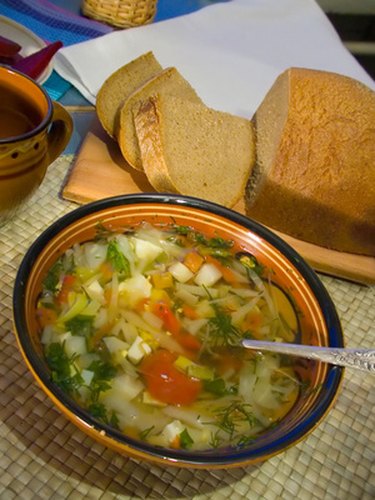
Removing a single tablespoon of olive oil from a serving of soup can lower the number of calories in the bowl by 119, according to SELFNutritionData. Pools of oil can also be unsightly in an otherwise visually stunning bowl of soup, leaving you or your guests with an unpleasant taste in their mouths. Even more significantly, fat -- which is liquid at high temperatures -- congeals and becomes lumpy when it is cold. This can be a disaster if you are going to serve your soup chilled, as your guests will likely not find a grayish or yellowish layer of solid fat in their bowls very appetizing. Fortunately, you can remove much of the excess oil from your soup with minimal effort.
Step 1
Remove the finished soup from the stove, and allow it to cool slightly. It does not need to actually get cold, but it needs to stop simmering or boiling long enough for the ingredients to settle and the oil to rise to the top.
Video of the Day
Step 2
Scoop the oil off the soup's surface with a soup skimmer, if you have one. If not, you can use a large spoon or a ladle instead. Drag the edge of the utensil just under the layer of oil to collect it, and then discard the contents of the skimmer, spoon or ladle. You will end up discarding a little bit of the soup in the process, but this is unfortunately unavoidable.
Step 3
Place the soup into the refrigerator if the oil you wish to remove comes from fats that will solidify. For example, if the oil in the hot soup comes from chicken fat, it will solidify at lower temperatures. If, however, it comes from olive oil, it will remain liquid, and refrigerating your soup in an attempt to remove more fat will be pointless.
Step 4
Remove the soup from the refrigerator after six to eight hours. By this point, the fat should have hardened into a solid layer on top of the soup. Scoop off the fat with a spoon or soup skimmer. Some of the fat may cling to the edge of the container around the top of the soup; scrape this off as well to remove even more oil from the finished product.
Video of the Day